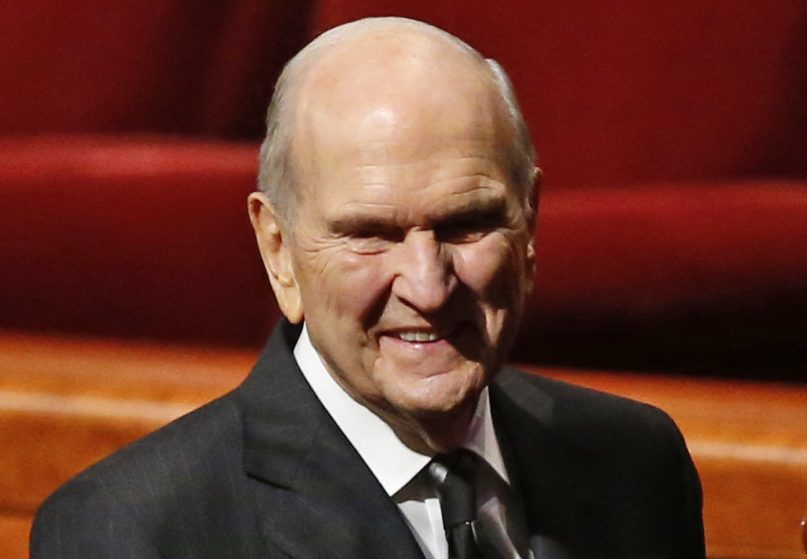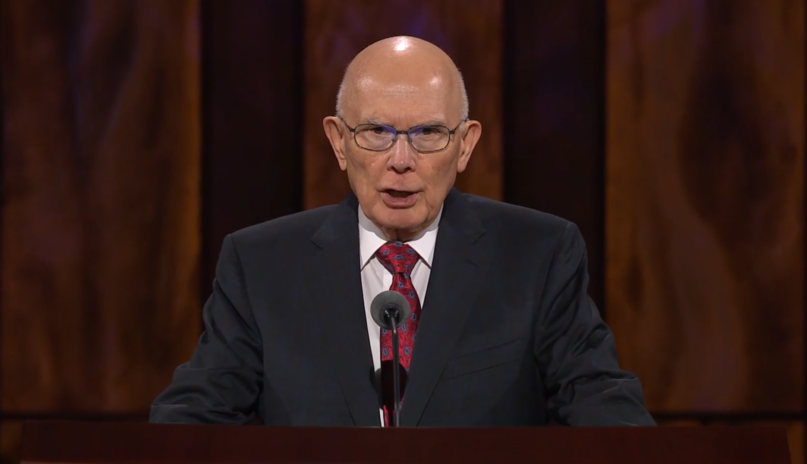
President Russell M. Nelson leaves the morning session of a twice-annual conference of The Church of Jesus Christ of Latter-day Saints on Oct. 6, 2018, in Salt Lake City. (AP Photo/Rick Bowmer)
(RNS) — This morning I scanned the Religion News Service headlines as I do every day. There’s a growing controversy about the late evangelist Ravi Zacharias, as the evidence of his sexual misconduct mounts and his colleagues attempt to reconcile the godly minister and author they thought they knew with the sexual predator he apparently was.
Also in today’s news, investigations have concluded in the case of Hillsong megachurch pastor Carl Lentz’s sexual misconduct, after the celebrity preacher admitted last year to being unfaithful to his wife.
Those evangelical dumpster fires are the kinds of stories I haven’t seen in my decade-plus of writing a national column about Mormonism, nor do I expect to. Right now, the church of Jesus Christ of Latter-day Saints is headed by a 96-year-old prophet. His two counselors in the First Presidency are ages 88 and 87, respectively.
With an average age of 90, this is the oldest First Presidency we have had in all of Mormon history.
But age is not the primary factor keeping experienced Latter-day Saint leaders far away from sexual misconduct. I mean, look at Zacharias. Before he died last year in his mid-70s, he apparently spent his golden years acquiring enough technological know-how to master the sexually explicit selfie.
Rather, in Mormonism, men like him are quietly (and too slowly) weeded out of the system. One of the highest-ranking Mormon leaders to be publicly accused of sexual misconduct was Joseph Bishop, who was a mission president in South America as well as the president of the Missionary Training Center during the mid-1980s. Bishop did not rise any higher than that, even though in a recorded interview from 2017 he acknowledged he knew he was once in the running to be called as a general authority:
When he had put my name in the hat to become a Seventy, I was never called. I know why. I know why. Because Carlos Asay may not have done what he should have done with you, but he did what he should have done with me.
What Bishop seems to be saying here is that although Elder Asay, the general authority who had allegedly been informed of a former missionary’s accusation Bishop had raped her while she was in the MTC, never responded directly to her on behalf of the church, he may have acted on that knowledge privately, making sure Bishop wasn’t promoted to become a general authority himself. (Before you go congratulating the church on doing the right thing in not promoting Bishop, consider it also allowed him to remain in leadership over young missionaries. The church’s official stance is that it was not informed of Bishop’s sexual misconduct until 2010. Bishop himself says he reported it when it happened in the 1980s, yet he remained in his post.)
In the top echelons of the First Presidency and Quorum of the 12 Apostles, Mormonism has not been rocked by a major sex scandal since 1943, when then-apostle Richard Lyman was excommunicated for an extramarital affair he had conducted in secret over nearly 20 years.
I think one consequence of the Lyman scandal of 1943 is that LDS apostles started getting called to the Twelve only when they grew older, became more seasoned. In the past, some had been called in their 40s, their 30s and even their 20s. Today, the sweet spot to be called as an apostle is when a man is in his early 60s and has already been groomed for years as a Seventy and/or mission president.
There are a number of benefits to having such experienced leadership, including the one I’ve been focusing on here: fewer sex scandals! That’s not something to dismiss lightly. But there are substantial drawbacks as well, including a failure to pivot to address needed change.
Latter-day Saints often proudly say the church is led by a prophet and apostles so these anointed leaders can speak to the needs of our particular time, but in reality the church is often dragged kicking and screaming into the present. Rather than taking the lead and speaking prophetically to counter injustice, it all too often openly resists the changes that lead to justice.
In large part that is because resistance to change is baked into the system.
Consider the issue of race. It’s good to see the strides the church has made in just the last few years in confronting racism. In 2017, after racially motivated violence in Charlottesville, it officially condemned white supremacy; in 2020 First Presidency counselor Dallin Oaks called out the problem of racism and declared Black lives matter.

Pres. Dallin H. Oaks delivers the talk “Love Your Enemies” at the October 2020 General Conference of the Church of Jesus Christ of Latter-day Saints. Video screengrab
But let’s be clear: Oaks and other LDS leaders hold the positions they do now because they long benefited from a system of white supremacy. Some who are in their 70s, 80s and 90s were already serving in leadership positions in the church in the 1970s, when the church continued its racist ban against Blacks entering the temple or holding the priesthood. Oaks, for example, was president of Brigham Young University when you could count its number of Black students on both hands — and having even that tiny contingent was considered progress.
In 2018, at the church’s “Be One” celebration to mark the 40th anniversary of the ban’s repeal, Oaks spoke of his joy in 1978 when Elder Boyd K. Packer phoned him with the news:
I sat down on the pile of dirt we had been moving and beckoned to my sons. As I told them that all worthy male members of the Church could now be ordained to the priesthood, I wept for joy. That is the scene etched in my memory of this unforgettable announcement 40 years ago — sitting on a pile of dirt and weeping as I told my sons of this divine revelation.
This is a beautiful recollection, and I’ve no doubt the tears were sincere. The church and its members had been roundly criticized for the persistence of the racist ban, and BYU had been particularly singled out as a focus of antiracist protesters. It was a painful time.
But the other reality is that, however happy the ban’s reversal made him, I’ve not found evidence Oaks ever went on the record as opposing it while it was in place. In fact, he says he made a conscious decision to keep silent despite any private discomfort he felt:
I studied the reasons then being given and could not feel confirmation of the truth of any of them. As part of my prayerful study, I learned that, in general, the Lord rarely gives reasons for the commandments and directions He gives to His servants. I determined to be loyal to our prophetic leaders and to pray — as promised from the beginning of these restrictions — that the day would come when all would enjoy the blessings of priesthood and temple.
This is an excellent case study of who gets promoted to leadership in the LDS church and why. It’s the loyalists, not the idealists or the agitators, the ones who are willing to toe the party line — even if that position is not one they agree with — the ones who have demonstrated over years and even decades they are adept at prioritizing the institution over the individual.
In terms of leadership, that means Mormonism is far more insulated from sex scandals or financial embezzlement than other conservative religions that gravitate toward charismatic individual leaders — the self-starters, the pastor-preneurs. That’s our silver lining.
The cost of that relative safety is that we have often misunderstood what “prophetic” is supposed to mean: speaking truth to power, again and again if necessary.
Related content:
LDS Church rebukes Mormon white supremacists, who rebuke the Church right back (8/17)
Forty years on, most Mormons still believe the racist priesthood/temple ban was God’s will (6/18)





